2010 MERCEDES-BENZ R320 roof rack
[x] Cancel search: roof rackPage 17 of 364
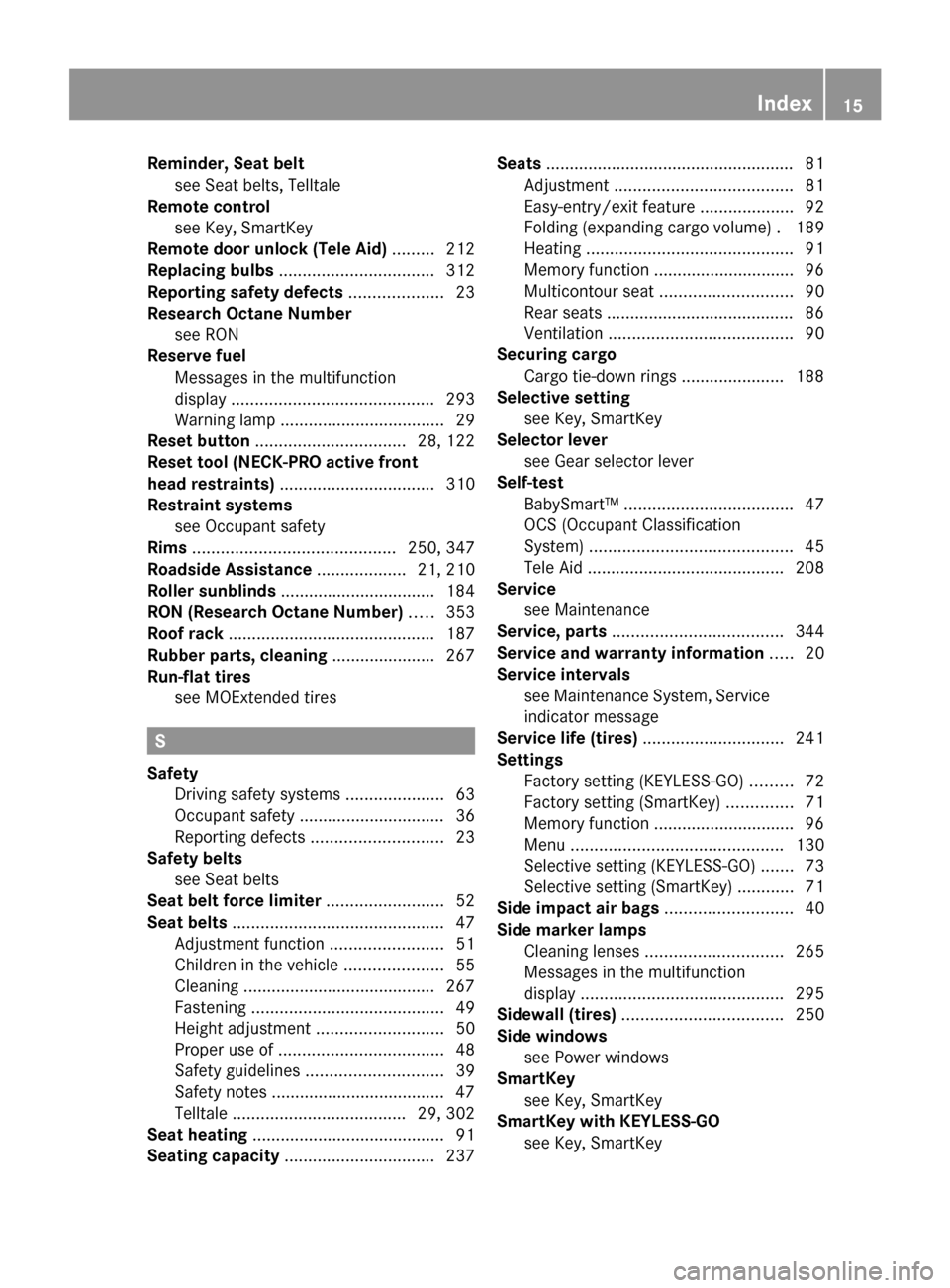
Reminder, Seat belt
see Seat belts, Telltale
Remote control
see Key, SmartKey
Remote door unlock (Tele Aid) .........212
Replacing bulbs ................................. 312
Reporting safety defects .................... 23
Research Octane Number see RON
Reserve fuel
Messages in the multifunction
display ........................................... 293
Warning lamp ................................... 29
Reset button ................................ 28, 122
Reset tool (NECK-PRO active front
head restraints) ................................. 310
Restraint systems see Occupant safety
Rims ........................................... 250, 347
Roadside Assistance ...................21, 210
Roller sunblinds ................................. 184
RON (Research Octane Number) ..... 353
Roof rack ............................................ 187
Rubber parts, cleaning ...................... 267
Run-flat tires see MOExtended tires S
Safety Driving safety systems ..................... 63
Occupant safety ...............................
36
Reporting defects ............................ 23
Safety belts
see Seat belts
Seat belt force limiter ......................... 52
Seat belts ............................................. 47
Adjustment function ........................51
Children in the vehicle .....................55
Cleaning ......................................... 267
Fastening ......................................... 49
Height adjustment ...........................50
Proper use of ................................... 48
Safety guidelines ............................. 39
Safety notes ..................................... 47
Telltale ..................................... 29, 302
Seat heating ......................................... 91
Seating capacity ................................ 237Seats .....................................................
81
Adjustment ...................................... 81
Easy-entry/exit feature ....................92
Folding (expanding cargo volume) . 189
Heating ............................................ 91
Memory function .............................. 96
Multicontour seat ............................ 90
Rear seats ........................................ 86
Ventilation ....................................... 90
Securing cargo
Cargo tie-down rings ...................... 188
Selective setting
see Key, SmartKey
Selector lever
see Gear selector lever
Self-test
BabySmart™ .................................... 47
OCS (Occupant Classification
System) ........................................... 45
Tele Aid .......................................... 208
Service
see Maintenance
Service, parts .................................... 344
Service and warranty information .....20
Service intervals see Maintenance System, Service
indicator message
Service life (tires) .............................. 241
Settings Factory setting (KEYLESS-GO) ......... 72
Factory setting (SmartKey) ..............71
Memory function .............................. 96
Menu ............................................. 130
Selective setting (KEYLESS-GO) ....... 73
Selective setting (SmartKey) ............71
Side impact air bags ...........................40
Side marker lamps
Cleaning lenses ............................. 265
Messages in the multifunction
display ........................................... 295
Sidewall (tires) .................................. 250
Side windows see Power windows
SmartKey
see Key, SmartKey
SmartKey with KEYLESS-GO
see Key, SmartKey Index
15 251_AKB; 4; 52, en-US
d2ureepe,
Version: 2.11.8.1 2009-03-23T09:22:52+01:00 - Seite 15
Page 20 of 364
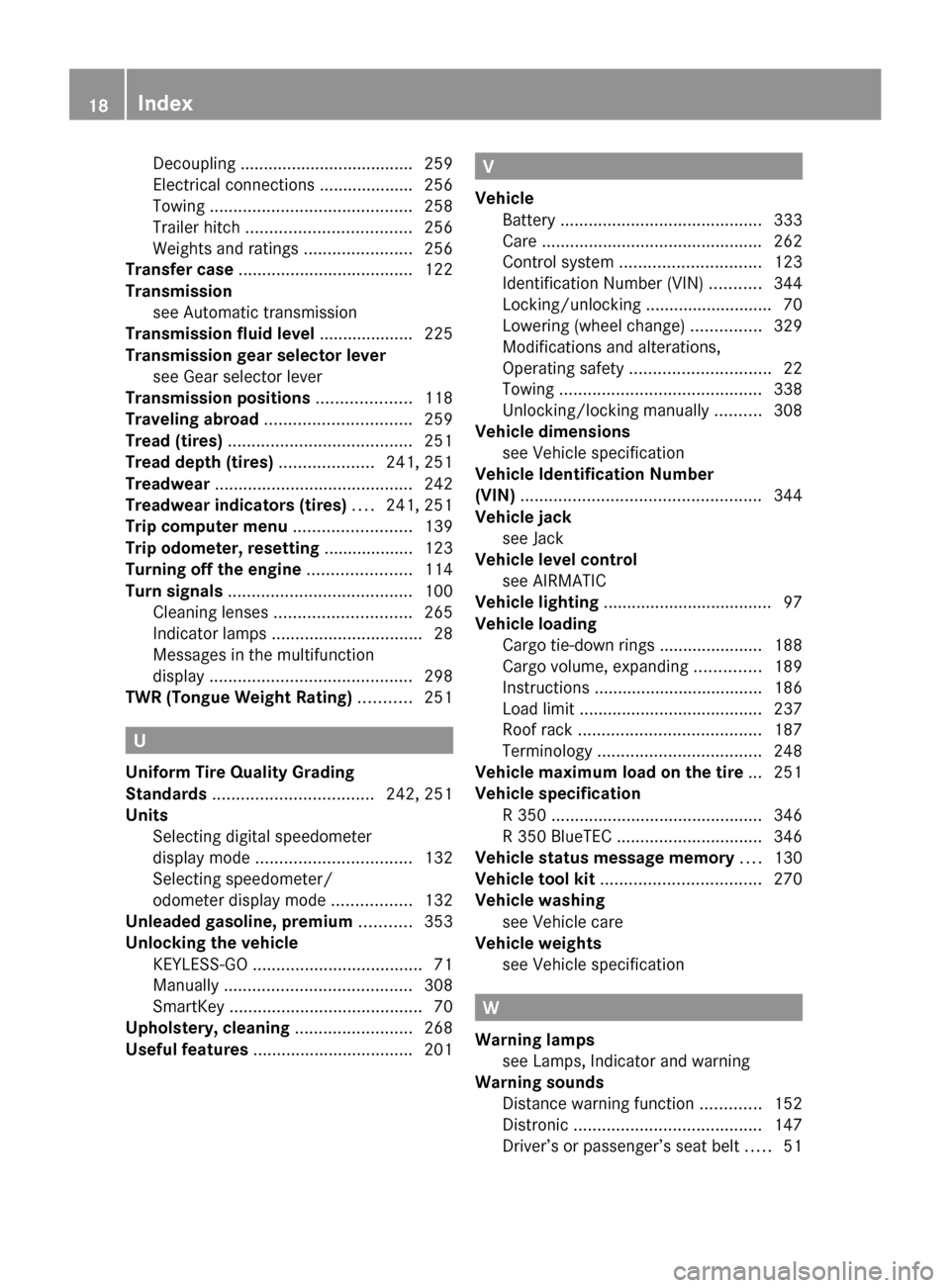
Decoupling ..................................... 259
Electrical connections
.................... 256
Towing ........................................... 258
Trailer hitch ................................... 256
Weights and ratings ....................... 256
Transfer case ..................................... 122
Transmission see Automatic transmission
Transmission fluid level .................... 225
Transmission gear selector lever see Gear selector lever
Transmission positions ....................118
Traveling abroad ............................... 259
Tread (tires) ....................................... 251
Tread depth (tires) ....................241, 251
Treadwear .......................................... 242
Treadwear indicators (tires) .... 241, 251
Trip computer menu .........................139
Trip odometer, resetting ................... 123
Turning off the engine ......................114
Turn signals ....................................... 100
Cleaning lenses ............................. 265
Indicator lamps ................................ 28
Messages in the multifunction
display ........................................... 298
TWR (Tongue Weight Rating) ........... 251U
Uniform Tire Quality Grading
Standards .................................. 242, 251
Units Selecting digital speedometer
display mode
................................. 132
Selecting speedometer/
odometer display mode ................. 132
Unleaded gasoline, premium ........... 353
Unlocking the vehicle
KEYLESS-GO .................................... 71
Manually ........................................ 308
SmartKey ......................................... 70
Upholstery, cleaning .........................268
Useful features .................................. 201 V
Vehicle
Battery ........................................... 333
Care ............................................... 262
Control system .............................. 123
Identification Number (VIN) ........... 344
Locking/unlocking
........................... 70
Lowering (wheel change) ...............329
Modifications and alterations,
Operating safety .............................. 22
Towing ........................................... 338
Unlocking/locking manually .......... 308
Vehicle dimensions
see Vehicle specification
Vehicle Identification Number
(VIN) ................................................... 344
Vehicle jack see Jack
Vehicle level control
see AIRMATIC
Vehicle lighting .................................... 97
Vehicle loading
Cargo tie-down rings ...................... 188
Cargo volume, expanding ..............189
Instructions .................................... 186
Load limit ....................................... 237
Roof rack ....................................... 187
Terminology ................................... 248
Vehicle maximum load on the tire ... 251
Vehicle specification
R 350 ............................................. 346
R 350 BlueTEC ............................... 346
Vehicle status message memory .... 130
Vehicle tool kit .................................. 270
Vehicle washing see Vehicle care
Vehicle weights
see Vehicle specification W
Warning lamps see Lamps, Indicator and warning
Warning sounds
Distance warning function .............152
Distronic ........................................ 147
Driver’s or passenger’s seat belt ..... 5118
Index 251_AKB; 4; 52, en-US
d2ureepe,
Version: 2.11.8.1 2009-03-23T09:22:52+01:00 - Seite 18
Page 189 of 364
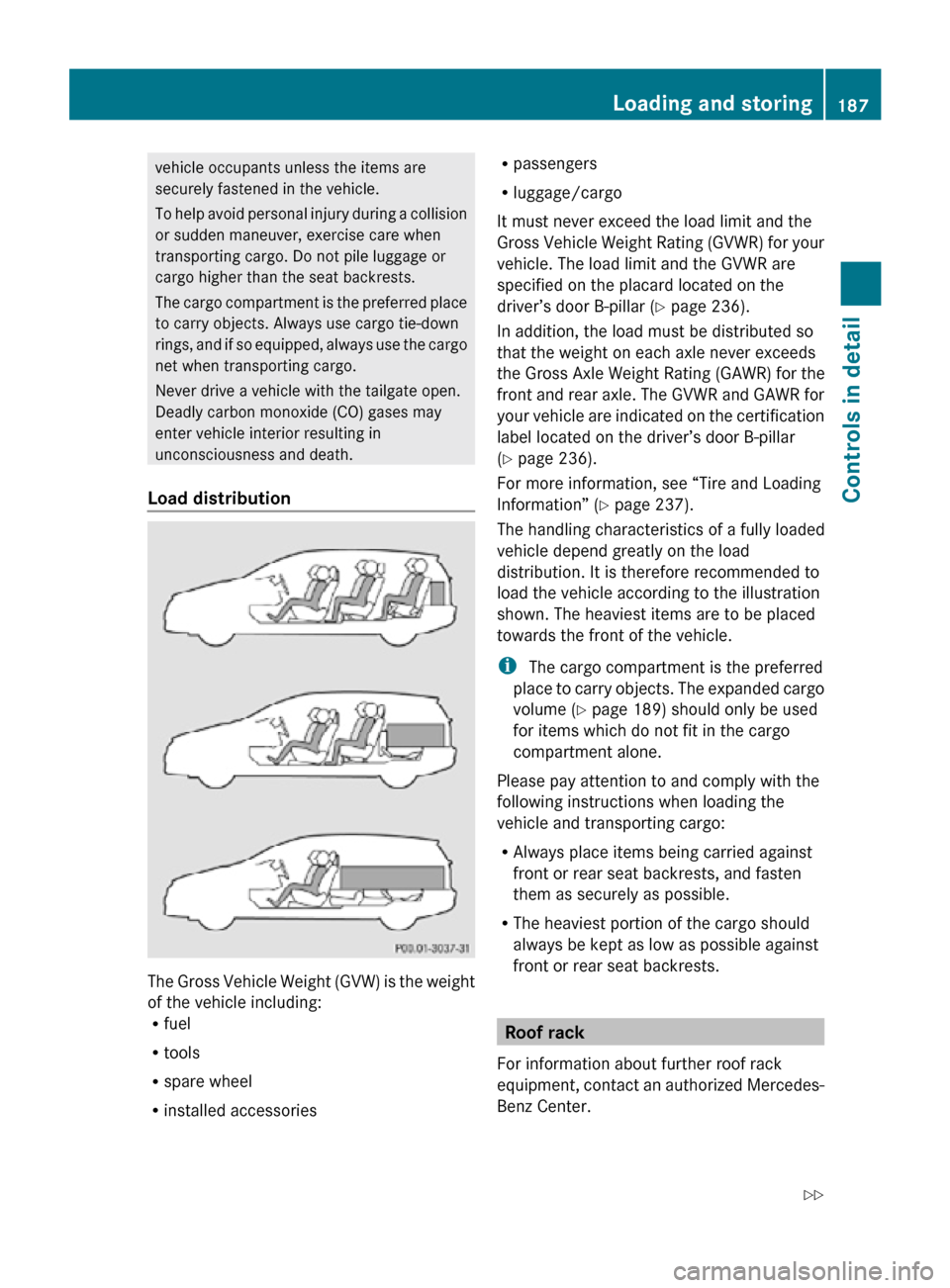
vehicle occupants unless the items are
securely fastened in the vehicle.
To help avoid personal injury during a collision
or sudden maneuver, exercise care when
transporting cargo. Do not pile luggage or
cargo higher than the seat backrests.
The cargo compartment is the preferred place
to carry objects. Always use cargo tie-down
rings, and if so equipped, always use the cargo
net when transporting cargo.
Never drive a vehicle with the tailgate open.
Deadly carbon monoxide (CO) gases may
enter vehicle interior resulting in
unconsciousness and death.
Load distribution The Gross Vehicle Weight (GVW) is the weight
of the vehicle including:
R
fuel
R tools
R spare wheel
R installed accessories R
passengers
R luggage/cargo
It must never exceed the load limit and the
Gross Vehicle Weight Rating (GVWR) for your
vehicle. The load limit and the GVWR are
specified on the placard located on the
driver’s door B-pillar ( Y page 236).
In addition, the load must be distributed so
that the weight on each axle never exceeds
the Gross Axle Weight Rating (GAWR) for the
front and rear axle. The GVWR and GAWR for
your vehicle are indicated on the certification
label located on the driver’s door B-pillar
(Y page 236).
For more information, see “Tire and Loading
Information” ( Y page 237).
The handling characteristics of a fully loaded
vehicle depend greatly on the load
distribution. It is therefore recommended to
load the vehicle according to the illustration
shown. The heaviest items are to be placed
towards the front of the vehicle.
i The cargo compartment is the preferred
place to carry objects. The expanded cargo
volume ( Y page 189) should only be used
for items which do not fit in the cargo
compartment alone.
Please pay attention to and comply with the
following instructions when loading the
vehicle and transporting cargo:
R Always place items being carried against
front or rear seat backrests, and fasten
them as securely as possible.
R The heaviest portion of the cargo should
always be kept as low as possible against
front or rear seat backrests. Roof rack
For information about further roof rack
equipment, contact an authorized Mercedes-
Benz Center. Loading and storing
187Controls in detail
251_AKB; 4; 52, en-US
d2ureepe, Version: 2.11.8.1 2009-03-23T09:22:52+01:00 - Seite 187 Z
Page 190 of 364
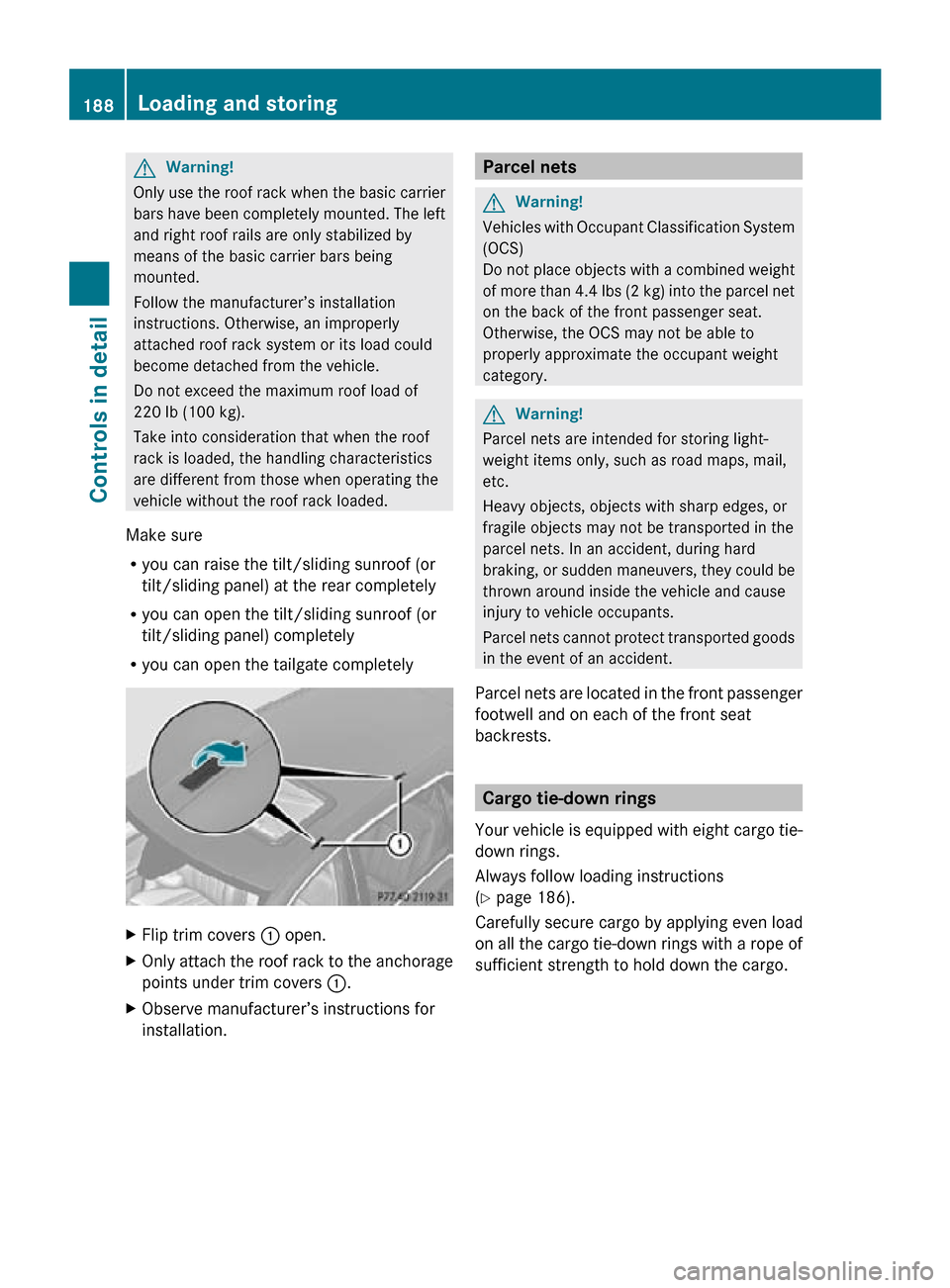
G
Warning!
Only use the roof rack when the basic carrier
bars have been completely mounted. The left
and right roof rails are only stabilized by
means of the basic carrier bars being
mounted.
Follow the manufacturer’s installation
instructions. Otherwise, an improperly
attached roof rack system or its load could
become detached from the vehicle.
Do not exceed the maximum roof load of
220 lb (100 kg).
Take into consideration that when the roof
rack is loaded, the handling characteristics
are different from those when operating the
vehicle without the roof rack loaded.
Make sure
R you can raise the tilt/sliding sunroof (or
tilt/sliding panel) at the rear completely
R you can open the tilt/sliding sunroof (or
tilt/sliding panel) completely
R you can open the tailgate completely X
Flip trim covers : open.
X Only attach the roof rack to the anchorage
points under trim covers :.
X Observe manufacturer’s instructions for
installation. Parcel nets
G
Warning!
Vehicles with Occupant Classification System
(OCS)
Do not place objects with a combined weight
of more than 4.4 lbs (2 kg) into the parcel net
on the back of the front passenger seat.
Otherwise, the OCS may not be able to
properly approximate the occupant weight
category. G
Warning!
Parcel nets are intended for storing light-
weight items only, such as road maps, mail,
etc.
Heavy objects, objects with sharp edges, or
fragile objects may not be transported in the
parcel nets. In an accident, during hard
braking, or sudden maneuvers, they could be
thrown around inside the vehicle and cause
injury to vehicle occupants.
Parcel nets cannot protect transported goods
in the event of an accident.
Parcel nets are located in the front passenger
footwell and on each of the front seat
backrests. Cargo tie-down rings
Your vehicle is equipped with eight cargo tie-
down rings.
Always follow loading instructions
(Y page 186).
Carefully secure cargo by applying even load
on all the cargo tie-down rings with a rope of
sufficient strength to hold down the cargo. 188
Loading and storingControls in detail
251_AKB; 4; 52, en-US
d2ureepe,
Version: 2.11.8.1 2009-03-23T09:22:52+01:00 - Seite 188
Page 252 of 364
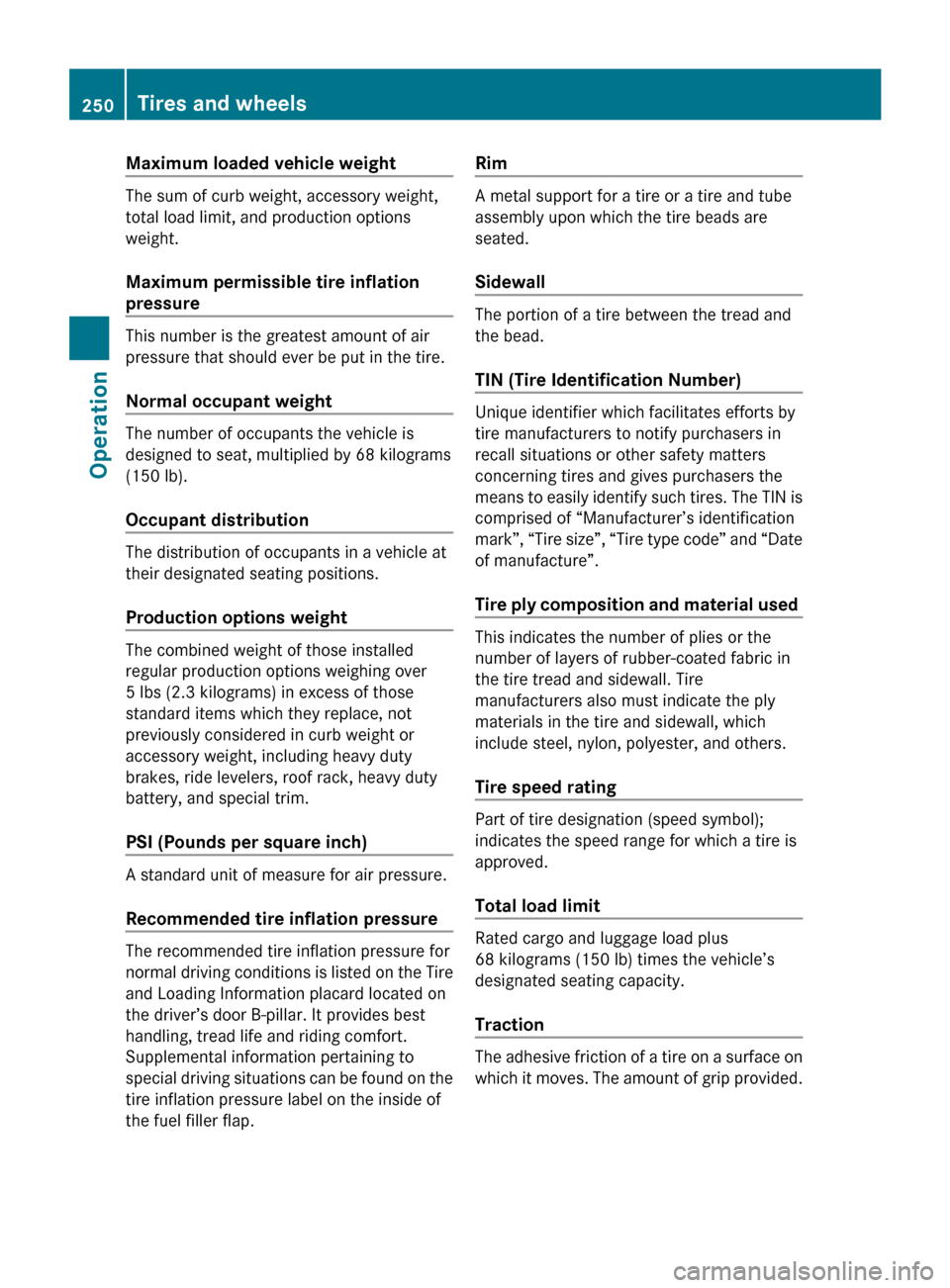
Maximum loaded vehicle weight
The sum of curb weight, accessory weight,
total load limit, and production options
weight.
Maximum permissible tire inflation
pressure
This number is the greatest amount of air
pressure that should ever be put in the tire.
Normal occupant weight
The number of occupants the vehicle is
designed to seat, multiplied by 68 kilograms
(150 lb).
Occupant distribution
The distribution of occupants in a vehicle at
their designated seating positions.
Production options weight
The combined weight of those installed
regular production options weighing over
5 lbs (2.3 kilograms) in excess of those
standard items which they replace, not
previously considered in curb weight or
accessory weight, including heavy duty
brakes, ride levelers, roof rack, heavy duty
battery, and special trim.
PSI (Pounds per square inch)
A standard unit of measure for air pressure.
Recommended tire inflation pressure
The recommended tire inflation pressure for
normal
driving conditions is listed on the Tire
and Loading Information placard located on
the driver’s door B-pillar. It provides best
handling, tread life and riding comfort.
Supplemental information pertaining to
special driving situations can be found on the
tire inflation pressure label on the inside of
the fuel filler flap. Rim A metal support for a tire or a tire and tube
assembly upon which the tire beads are
seated.
Sidewall
The portion of a tire between the tread and
the bead.
TIN (Tire Identification Number)
Unique identifier which facilitates efforts by
tire manufacturers to notify purchasers in
recall situations or other safety matters
concerning tires and gives purchasers the
means
to easily identify such tires. The TIN is
comprised of “Manufacturer’s identification
mark”, “Tire size”, “Tire type code” and “Date
of manufacture”.
Tire ply composition and material used This indicates the number of plies or the
number of layers of rubber-coated fabric in
the tire tread and sidewall. Tire
manufacturers also must indicate the ply
materials in the tire and sidewall, which
include steel, nylon, polyester, and others.
Tire speed rating
Part of tire designation (speed symbol);
indicates the speed range for which a tire is
approved.
Total load limit
Rated cargo and luggage load plus
68 kilograms (150 lb) times the vehicle’s
designated seating capacity.
Traction
The adhesive friction of a tire on a surface on
which
it moves. The amount of grip provided. 250
Tires and wheels
Operation
251_AKB; 4; 52, en-US
d2ureepe,
Version: 2.11.8.1 2009-03-23T09:22:52+01:00 - Seite 250
Page 268 of 364
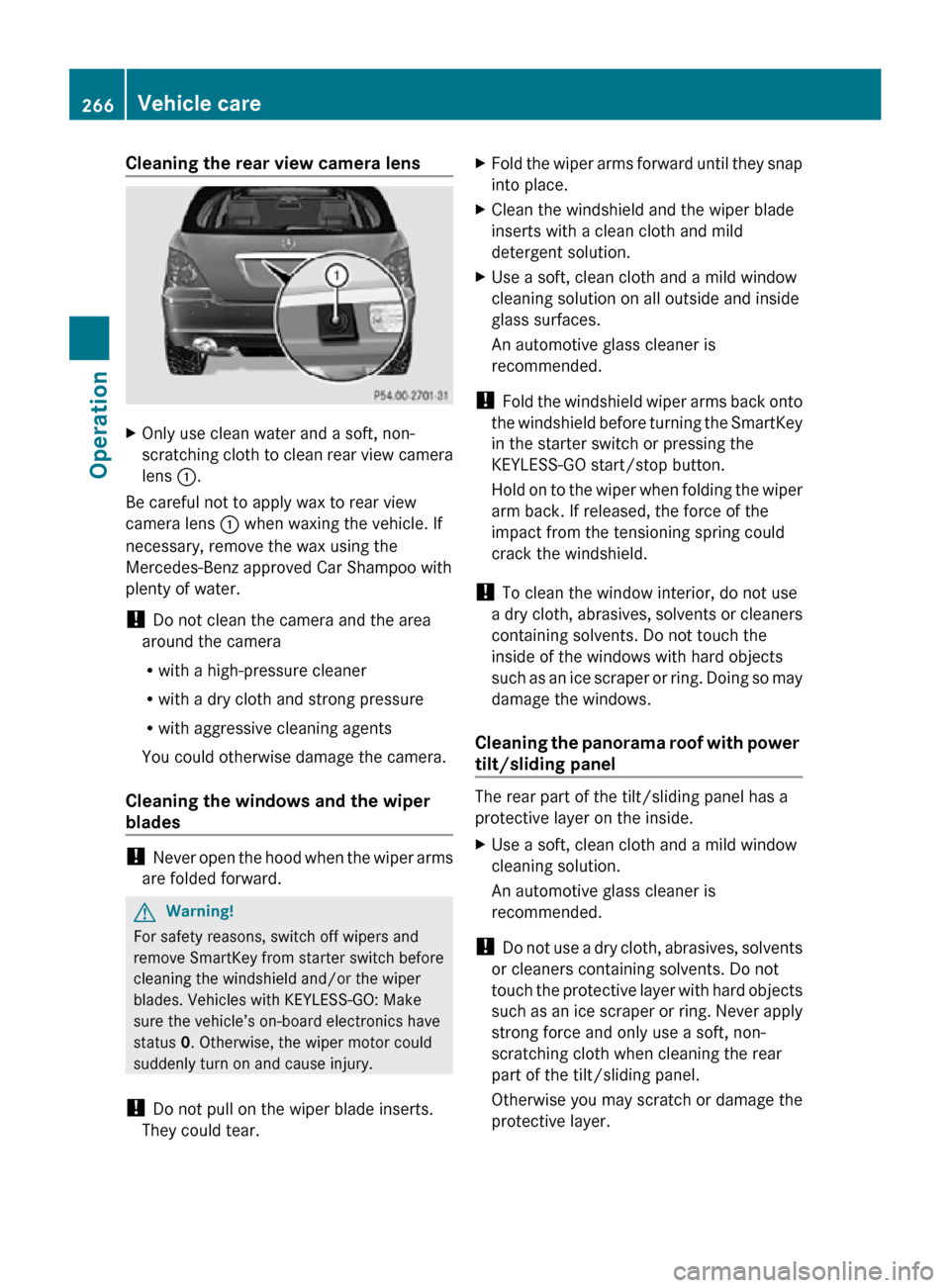
Cleaning the rear view camera lens
X
Only use clean water and a soft, non-
scratching cloth to clean rear view camera
lens :.
Be careful not to apply wax to rear view
camera lens : when waxing the vehicle. If
necessary, remove the wax using the
Mercedes-Benz approved Car Shampoo with
plenty of water.
! Do not clean the camera and the area
around the camera
R with a high-pressure cleaner
R with a dry cloth and strong pressure
R with aggressive cleaning agents
You could otherwise damage the camera.
Cleaning the windows and the wiper
blades !
Never open the hood when the wiper arms
are folded forward. G
Warning!
For safety reasons, switch off wipers and
remove SmartKey from starter switch before
cleaning the windshield and/or the wiper
blades. Vehicles with KEYLESS-GO: Make
sure the vehicle’s on-board electronics have
status 0. Otherwise, the wiper motor could
suddenly turn on and cause injury.
! Do not pull on the wiper blade inserts.
They could tear. X
Fold the wiper arms forward until they snap
into place.
X Clean the windshield and the wiper blade
inserts with a clean cloth and mild
detergent solution.
X Use a soft, clean cloth and a mild window
cleaning solution on all outside and inside
glass surfaces.
An automotive glass cleaner is
recommended.
! Fold the windshield wiper arms back onto
the windshield before turning the SmartKey
in the starter switch or pressing the
KEYLESS-GO start/stop button.
Hold on to the wiper when folding the wiper
arm back. If released, the force of the
impact from the tensioning spring could
crack the windshield.
! To clean the window interior, do not use
a dry cloth, abrasives, solvents or cleaners
containing solvents. Do not touch the
inside of the windows with hard objects
such as an ice scraper or ring. Doing so may
damage the windows.
Cleaning the panorama roof with power
tilt/sliding panel The rear part of the tilt/sliding panel has a
protective layer on the inside.
X
Use a soft, clean cloth and a mild window
cleaning solution.
An automotive glass cleaner is
recommended.
! Do not use a dry cloth, abrasives, solvents
or cleaners containing solvents. Do not
touch the protective layer with hard objects
such as an ice scraper or ring. Never apply
strong force and only use a soft, non-
scratching cloth when cleaning the rear
part of the tilt/sliding panel.
Otherwise you may scratch or damage the
protective layer. 266
Vehicle careOperation
251_AKB; 4; 52, en-US
d2ureepe,
Version: 2.11.8.1 2009-03-23T09:22:52+01:00 - Seite 266
Page 348 of 364
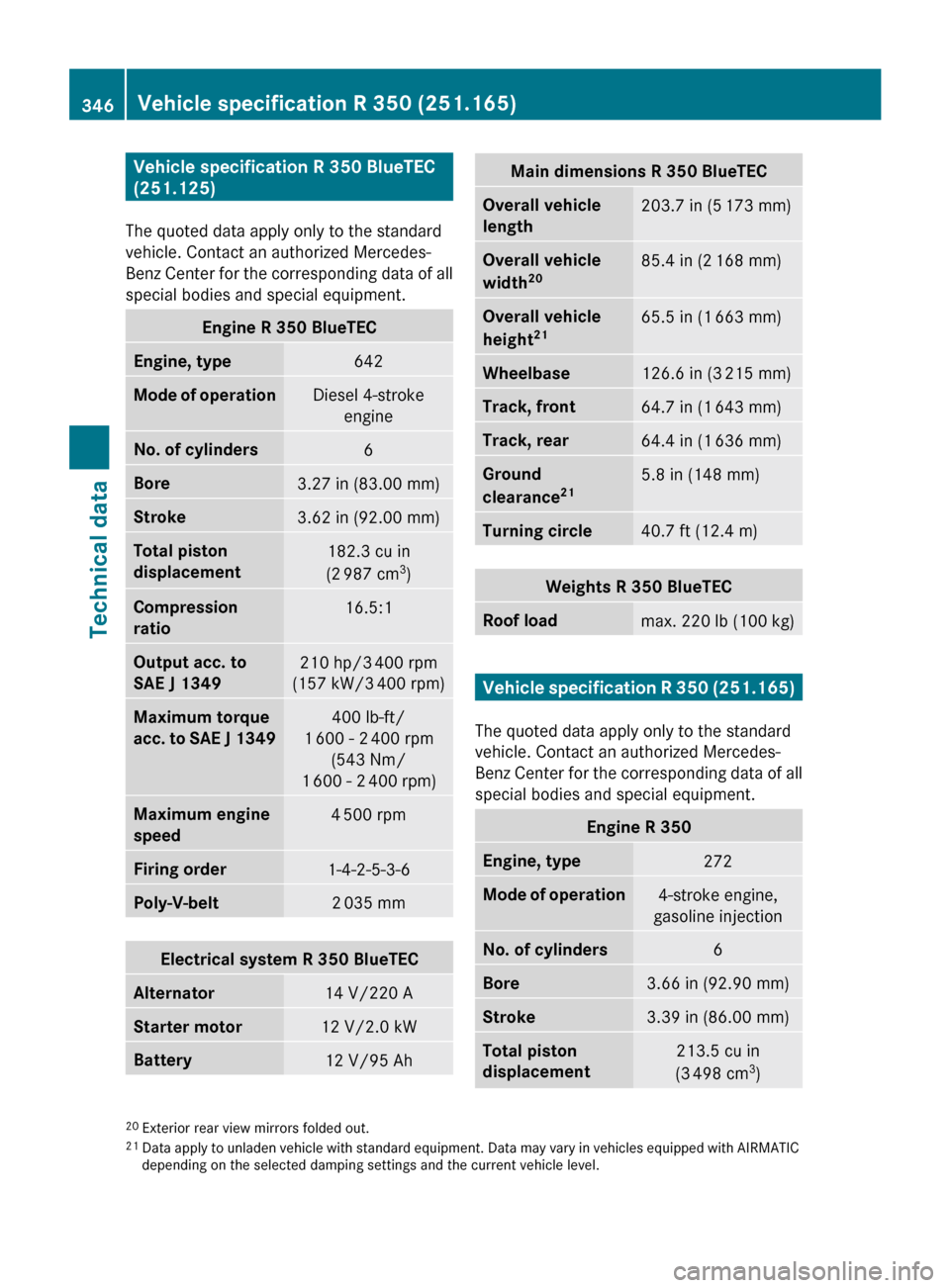
Vehicle specification R 350 BlueTEC
(251.125)
The quoted data apply only to the standard
vehicle. Contact an authorized Mercedes-
Benz
Center for the corresponding data of all
special bodies and special equipment. Engine R 350 BlueTEC
Engine, type
642
Mode of operation
Diesel 4-stroke
engine No. of cylinders
6
Bore
3.27 in (83.00 mm)
Stroke
3.62 in (92.00 mm)
Total piston
displacement
182.3 cu in
(2 987 cm 3
) Compression
ratio
16.5:1
Output acc. to
SAE J 1349
210 hp/3
400 rpm
(157 kW/3 400 rpm) Maximum torque
acc.
to SAE J 1349 400 lb-ft/
1 600 - 2 400 rpm
(543 Nm/
1 600 - 2 400 rpm) Maximum engine
speed
4 500 rpm
Firing order
1-4-2-5-3-6
Poly-V-belt
2 035 mm
Electrical system R 350 BlueTEC
Alternator
14 V/220 A
Starter motor
12 V/2.0 kW
Battery
12 V/95 Ah Main dimensions R 350 BlueTEC
Overall vehicle
length
203.7 in (5
173 mm) Overall vehicle
width
20 85.4 in (2
168 mm) Overall vehicle
height
21 65.5 in (1
663 mm) Wheelbase
126.6 in (3
215 mm) Track, front
64.7 in (1
643 mm) Track, rear
64.4 in (1
636 mm) Ground
clearance
21 5.8 in (148 mm)
Turning circle
40.7 ft (12.4 m)
Weights R 350 BlueTEC
Roof load
max. 220 lb (100 kg)
Vehicle specification R 350 (251.165)
The quoted data apply only to the standard
vehicle. Contact an authorized Mercedes-
Benz
Center for the corresponding data of all
special bodies and special equipment. Engine R 350
Engine, type
272
Mode of operation
4-stroke engine,
gasoline injection No. of cylinders
6
Bore
3.66 in (92.90 mm)
Stroke
3.39 in (86.00 mm)
Total piston
displacement
213.5 cu in
(3 498 cm 3
) 20
Exterior rear view mirrors folded out.
21 Data
apply to unladen vehicle with standard equipment. Data may vary in vehicles equipped with AIRMATIC
depending on the selected damping settings and the current vehicle level. 346
Vehicle specification R 350 (251.165)
Technical data
251_AKB; 4; 52, en-US
d2ureepe,
Version: 2.11.8.1 2009-03-23T09:22:52+01:00 - Seite 346
Page 349 of 364

Engine R 350
Compression
ratio
10.7:1
Output acc. to
SAE J 1349
22 268 hp/6
000 rpm
(200 kW/6 000 rpm) Maximum torque
acc.
to SAE J 1349 258 lb-ft/
2 400 - 5 000 rpm
(350 Nm/
2 400 - 5 000 rpm) Maximum engine
speed
6 500 rpm
Firing order
1-4-3-6-2-5
Poly-V-belt
2 404 mm
Electrical system R 350
Alternator
14 V/180 A
Starter motor
12 V/1.4 kW
Battery
12 V/70 Ah
Spark plugs, type
Bosch Y 7 MPP33
Spark plugs,
electrode gap
0.031 in (0.8 mm)
Spark plugs,
tightening torque
15 - 18 lb-ft
(20 - 25 Nm) Main dimensions R 350
Overall vehicle
length
203.7 in (5
173 mm) Overall vehicle
width
23 85.4 in (2
168 mm) Overall vehicle
height
24 65.5 in (1
663 mm) Wheelbase
126.6 in (3
215 mm) Main dimensions R 350
Track, front
64.7 in (1
643 mm) Track, rear
64.4 in (1
636 mm) Ground
clearance
24 5.8 in (148 mm)
Turning circle
40.7 ft (12.4 m)
Weights R 350
Roof load
max. 220 lb (100 kg)
Rims and tires
Notes
! Only
use tires which have been tested and
approved by Mercedes-Benz. Tires
approved by Mercedes-Benz are developed
to provide best possible performance in
conjunction with the driving safety systems
on your vehicle such as the ABS or the
ESP ®
. Tires specially developed for your
vehicle and tested and approved by
Mercedes-Benz can be identified by finding
the following on the tire’s sidewall:
R MO = Mercedes-Benz Original
equipment tires
R MOE
= Mercedes-Benz Original Extended
(tires with limited run-flat
characteristics) original equipment tires
Using tires other than those approved by
Mercedes-Benz may result in damage that
is not covered by the Mercedes-Benz
Limited Warranty.
For information on driving with MOExtended
tires, see the “Practical hints” section
(Y page 330).
22 Premium fuel required. Performance may vary with fuel octane rating.
23 Exterior rear view mirrors folded out.
24 Data
apply to unladen vehicle with standard equipment. Data may vary in vehicles equipped with AIRMATIC
depending on the selected damping settings and the current vehicle level. Rims and tires
347
Technical data
251_AKB; 4; 52, en-US
d2ureepe, Version: 2.11.8.1 2009-03-23T09:22:52+01:00 - Seite 347 Z